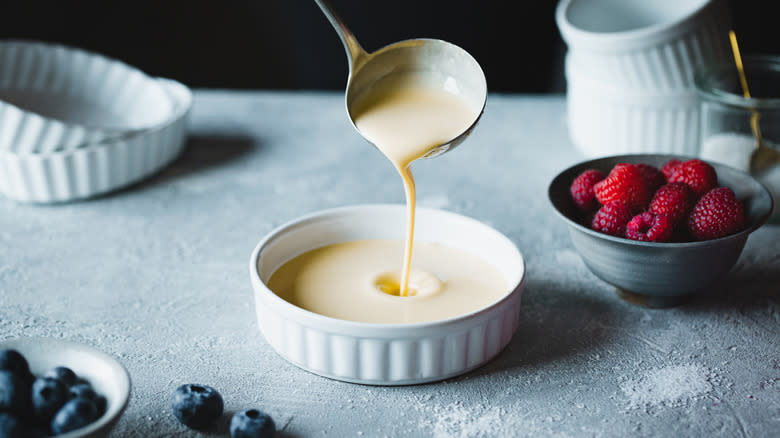The Mistake You're Making While Pouring Crème Brûlée Mix

Many homebakers make a common mistake when making crème brûlée for the first time. And it's warranted, granted that crème brûlée is not the easiest dessert to make. After all, it is a custard that dances on a fine line between being silky and firm. Thus, perfecting crème brûlée at home requires a bit of finesse, especially while pouring the crème brûlée mix, which is where mistakes usually happen.
Making crème brûlée requires heating heavy cream to a simmer or gentle boil first. Once the heavy cream is hot enough, bakers are tempted to pour all of it at once into the egg yolks. This is the mistake we're talking about because instead of making crème brûlée, you'll be making scrambled eggs.
To prevent this, the key is to always temper the egg yolks first. When you temper eggs, you're gently and slowly cooking and stabilizing them while keeping their beaten, liquid form. The heat involved in the tempering process is not high enough to curdle the eggs or transform the proteins from liquid to solid.
Read more: 25 Best Ice Cream Brands Ranked
How To Properly Temper Egg Yolks When Making Crème Brûlée At Home

What is the proper way to temper eggs when making crème brûlée? First, heat up the heavy cream, as aforementioned. Then add the hot, heavy cream to the egg yolks, but only a few teaspoons at a time, while constantly whisking the mixture. Then, gradually pour in the rest of the hot cream in a steady trickle or a ladle-full at a time. The key is to work slowly and gently while pouring. Avoid giving in to impatience and dumping in all the hot, heavy cream at once, and continue to whisk.
The egg yolk and heavy cream mixture should be nice, smooth, devoid of clumpy eggs, and ready for you to transfer to ramekins for baking. This methodical approach not only ensures the custard base for your crème brûlée is velvety and lump-free but also serves as a fundamental skill in the kitchen, applicable to a variety of recipes requiring tempered eggs, such as pastry cream, pasta carbonara, and ice cream.
Read the original article on Tasting Table.

 Yahoo Lifestyle
Yahoo Lifestyle 
